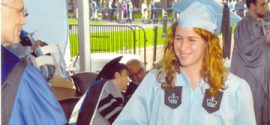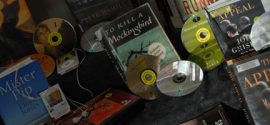One Dyslexic’s Experience with Learning American Sign Language

Enlightened schools are often looking for ways for students to fulfill their curriculum requirements while accommodating the needs of dyslexic students. When Dr. Sally Shaywitz learned of CJ, a ninth-grader with dyslexia at a traditional independent school who chose to substitute a summer semester of American Sign Language for his foreign language requirement, Dr. Shaywitz and The Yale Center for Dyslexia & Creativity (YCDC) reached out to him to see how such a course would work for a dyslexic. With a longstanding history of dyslexia that has been well supported over the years, CJ graciously offered to share his experience with visitors to the YCDC website. What resulted was an inspirational pilot project that offers an alternative that other dyslexic students with language requirements might want to think about, as well as some issues that schools should consider.
“So if you have trouble learning the sound system of your primary language, you will have enormous difficulties learning the sound system of a second language. This applies to about 99 percent of dyslexics.”
“We know that dyslexic individuals have trouble accessing the individual sounds of spoken words,” says Dr. Shaywitz. “So if you have trouble learning the sound system of your primary language, you will have enormous difficulties learning the sound system of a second language. This applies to about 99 percent of dyslexics—but not everyone, though. A friend of YCDC majored in Spanish, earning academic honors. And a patient of mine learned Persian by using flash cards to study and she also did a summer course where it was intensively Persian and she didn’t have to balance her other work, and that is the other component that probably worked for CJ—he got to take this course in the summer and got to really focus on learning the language.”
Indeed, CJ, who is a hard-working A/B student, chose not to take a foreign language in high school, after taking Spanish in fourth and fifth grades and experiencing the same difficulty learning Spanish as he did learning how to read and write the English language. He was the only student in his class who opted for a foreign language waiver. But with taking this waiver, CJ realized that not taking a foreign language in high school would limit his college options, so he searched for an alternative.
He found an American Sign Language (ASL) summer course offered at a local community college and decided to enroll. Each class was held for three hours, three times a week, for a total of six weeks. There were 25 students in the class and CJ reports that all of the students had some kind of learning difficulty. His teacher was deaf but could hear with a device that she wore. However, English was not spoken in class and only ASL was used.
“My name is CJ. I am learning sign language. Thank you for reading the article.”
CJ found learning ASL fairly easy. In each class he was given 45-50 vocabulary words to learn. He used the Internet to print pictures of the words and then turned to the ASL dictionary for their meaning. After pasting the meaning of the words on to the pictures he then studied the words, reviewing them each 5-6 times, and asking his parents to quiz him. Upon returning to class he was given a quiz; his teacher would sign in front of the class and he would have to write down the word or phrase that was signed. The next time class met these words were reviewed and then a new set of 45-50 words was introduced. This pattern of instruction was fairly consistent and CJ learned over 800 words during the six-week class.
During the first two weeks of class, CJ’s teacher expected him to learn ASL for the words assigned. Throughout the second two weeks he was expected to use the signs more fluidly, and during the final two weeks he was to sign words with some automaticity. CJ attributes his ease of learning words to his being organized and dedicating time to studying. He found learning sign language easier than learning English vocabulary because ASL is so visual and hands-on. Hand gestures depict words and their meaning rather than his having to use words to express meaning.
One of the highlights of the course was breaking into small groups and conversing in sign language. CJ enjoyed these discussions because they required him to use what he had learned and there was a purpose to the conversations. He did find it challenging to watch videos where people were signing. The videos moved so quickly that CJ did not always have time to comprehend all of the signing, which often left him frustrated and confused. Watching videos where signing was the primary language did become easier as he progressed through the course, but it remained difficult to watch a movie and take notes simultaneously. He also learned a little about the culture of the deaf community through watching a film about the conflict between the deaf and hearing worlds.
While CJ passed all assessments and the course with flying colors—earning an A—he is not able to sign fluidly. He is capable of expressing his ideas if he signs slowly, but he struggles to keep pace with anyone who knows sign language well. However, his experience is similar to that of any student in an introductory foreign language course, and CJ does believe that his ability to sign is equal to that of his classmates.
“ASL is definitely worth taking,” says CJ. “It is more hands-on and visual and that makes it easier to learn, much easier than I anticipated.”
Despite a few frustrations, “ASL is definitely worth taking,” says CJ. “It is more hands-on and visual and that makes it easier to learn, much easier than I anticipated.” His plan is to complete three summer ASL courses for which he hopes to receive foreign language credit.
CJ’s strategy could work for a lot of dyslexic students who struggle with a particular subject area, such as a foreign language. According to Dr. Shaywitz, “If you have the time and you can have the intensity to practice and focus, it can be done—or it’s certainly worth a try. The fact that something is difficult and you have to take it with a full course load can be very destructive. One, it consumes an inordinate amount of time AND you’re always feeling guilty because you’re not able to devote the time to courses where you can excel and get so much more out of them.” Taking a summer course that concentrates on the subject matter that is difficult helps alleviate that.
“I think that many schools don’t appreciate what studying a foreign language takes out of a very bright, motivated, hard-working person who is dyslexic,” observes Dr. Shaywitz. “We at Yale, I’m so proud to say, saw the light maybe a decade ago, and we offer a partial waiver of the foreign language requirement to students who are dyslexic. The student applies, the application is reviewed, and a determination is made. This has been an extraordinarily successful program, both for the university and for the student. Many of the students have taken courses in the culture of a foreign country, and these alternative courses have often turned out to be a cornerstone of their future studies and careers. If any schools are considering such programs, we here at the Yale Center are more than happy to share our experience.”
CJ is an A-B student who works hard in and out of the classroom. He is an Eagle Scout, plays basketball and the piano, and is on a travel baseball team. Presently, he compensates for his dyslexia by listening to audio books (Learning Ally), using the Livescribe Smartpen in core classes for note taking (Nuance), and receiving tutoring for written language twice weekly. Many thanks to CJ who so willingly made himself available to speak each week and who kept a journal of the ASL course.
Related


How Extended Time Improved More than Just Test Scores
Allison at her graduation from Columbia University, where she earned her master’s degree. Learning is not a game …
Read More
Giving Voice to a Young Person’s Dyslexia Journey
Jennifer realized she could help other kids—and their parents—by telling her own story, the story of a 12-year-old …
Read More
Life Lessons from a Lifelong Learner
Magical Thinking, Rage and Small Steps on the Dyslexia Journey By the Reverend Charles F. Harper, M.Div., Yale …
Read More